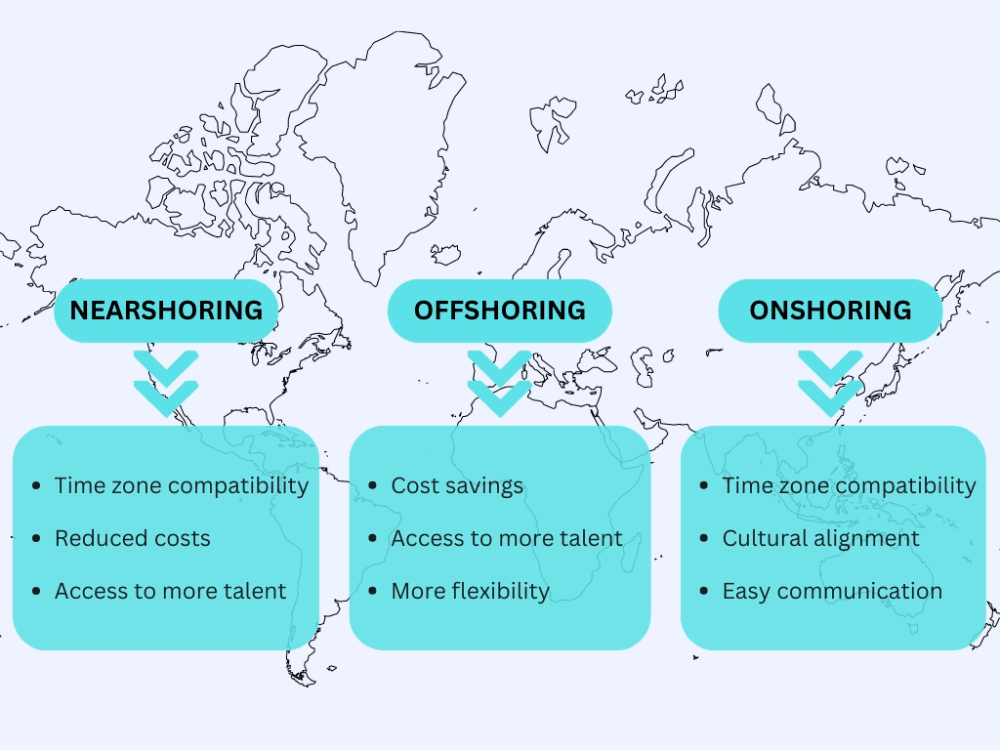Nearshore vs Offshore vs OnShore in Outsourcing: Differences and Benefits

About us
MoldoWEB is a software development company, located in Romania, specialized in providing outsourcing and team augmentation services for clients around the world.
Table of contents
- What is Nearshore Outsourcing?
- Key Advantages of Nearshore Outsourcing
- What is Offshore Outsourcing?
- Key Advantages of Offshore Outsourcing
- What is Onshore Outsourcing?
- Key Advantages of Onshore Outsourcing
- Key Differences Between Offshore, Onshore, and Nearshore Outsourcing
- Which Outsourcing Option to Choose
- Conclusion
Outsourcing has become an essential strategy for many companies looking to improve their operations, cut costs, and access specialized skills. When exploring outsourcing, you’ll come across three main options: nearshore, offshore, and onshore. Each has its own set of benefits, so choosing the right model is a major factor for a successful partnership.
One of the most important factors for a successful outsourcing partnership is selecting the right team for your project. The team you choose can greatly influence whether your business goals are achieved.
In this blog post, we’ll take a closer look at nearshore, offshore, and onshore outsourcing. We aim to help you understand each option better, so you can make informed decisions that align with your business objectives.
What is Nearshore Outsourcing?
Nearshore outsourcing means hiring a company in a nearby country to handle business projects. This helps companies take advantage of being close to each other, having similar cultures, and being in the same time zone. It also helps reduce some of the issues that come with offshoring. In the software development industry, nearshore outsourcing has become popular for accessing skilled workers, cutting costs, and improving collaboration.
Let's consider an example where a company in Germany decides to outsource a software development project to a team in Romania.

Key Advantages of Nearshore Outsourcing
Nearshore outsourcing brings a lot of practical benefits for businesses. Being close to each other geographically and sharing the same time zones makes it much easier for companies to communicate and work together. They can coordinate in real-time, which helps get things done more efficiently.
Cultural similarities are another big plus. When the outsourcing partner comes from a similar cultural background, they understand the business practices and work habits better. This makes the whole process smoother and more effective. Speaking the same language also helps a lot, as it makes communication clear and straightforward.
Cost is a big factor too. Outsourcing to nearby countries is often cheaper than hiring local companies. Businesses can save a lot of money without compromising on quality. Travel is also easier and more affordable when the outsourcing partner is close by. This makes it possible to have face-to-face meetings and visits when needed, which strengthens the working relationship.
Finally, working with nearby countries helps maintain a consistent business environment. Similar economic and market conditions mean fewer surprises and smoother operations. This continuity ensures that the outsourced work fits well with the client’s overall business goals. Overall, nearshore outsourcing offers a practical and effective way to enhance business operations.
What is Offshore Outsourcing?
Offshore outsourcing is when a company partners with a service provider in a different country, usually far away. This allows businesses to access international resources, such as specialized skills and better operational abilities, while saving money. By using offshore outsourcing, companies can benefit from lower labor costs and favorable economic conditions in specific regions. This cost-saving strategy helps companies use their resources more efficiently and improve their financial performance.
A good example of offshore outsourcing would be a company based in the United States outsourcing its software development tasks or projects to a skilled team in Romania.

Key Advantages of Offshore Outsourcing
Companies can save on costs by moving work to countries with lower labor and operating costs. This helps them reduce expenses without sacrificing quality.
Another advantage is access to skilled talent. Many offshore locations have a large number of professionals with specialized skills, making it easier for companies to find the right people for the job.
Offshore outsourcing allows companies to adjust the number of workers on a project as quickly as needed, making it easier to manage changing workloads and providing flexibility.
Having teams in different time zones allows work to continue around the clock, which leads to faster project completion and longer operational hours, boosting overall productivity.
With offshore outsourcing, companies get to focus on their core strengths and strategic goals by delegating less important tasks to offshore partners. This ultimately helps them grow and become more competitive.
Overall, offshore outsourcing is a smart business strategy, a way to improve business operations and achieve growth.
What is Onshore Outsourcing?
In onshore outsourcing, a company works with a service provider in the same country or region to assign specific tasks or projects. This helps the company make the most of local expertise, infrastructure, and proximity to improve how it operates and grows. By teaming up with local service providers, companies can take advantage of their knowledge of the local market, industry standards, and technological advancements.
An example of onshore outsourcing is when a company hires another company within the same country in which they operate, as in the image below:

Key Advantages of Onshore Outsourcing
Onshore outsourcing makes working together easier because the client and service provider are in the same country. Being in similar time zones means that communication can happen in real-time, tasks can be coordinated more smoothly, and response times are quicker.
Another great thing about onshore outsourcing is that it eliminates language and cultural barriers. Working with a company from the same country means that everyone understands each other better. There’s no need to worry about miscommunications or cultural misunderstandings, which makes the working relationship smoother and more efficient.
Quality and compliance are also easier to manage with onshore outsourcing. When both the client and the service provider follow the same rules, it's easier to make sure that everything is done the right way. This helps the clients know that the work will be okay with the local rules.
Protecting intellectual property (IP) is a strong point of onshore outsourcing because domestic laws offer better protection for sensitive information and proprietary processes. This means businesses can feel more secure about their trade secrets and other important information.
Local service providers, based in the same area as their clients have a good understanding of the local market. This includes knowing what consumers like and current trends in the industry. This knowledge is valuable because it helps customize services to meet the specific needs of the client's market.
Finally, hiring local companies for outsourcing helps the local economy. It creates jobs and supports local industries, leading to economic growth and stronger local communities.
Onshore outsourcing offers practical benefits like easier communication, better cultural fit, stronger legal protections, and a positive economic impact.
Key Differences Between Offshore, Onshore, and Nearshore Outsourcing
When choosing an outsourcing model, businesses have three main options: offshore, onshore, and nearshore, each with its own set of benefits and challenges.
Offshore outsourcing is often chosen for its cost savings, but it can come with difficulties in communication, cultural differences, and keeping up with local laws.
Onshore outsourcing, on the other hand, focuses on being close by, which helps with communication, understanding local culture, and protecting intellectual property. However, it usually comes with higher labor costs.
Nearshore outsourcing offers a middle ground. It provides some cost savings while being geographically closer, which helps with cultural alignment and navigating local regulations more easily.
When deciding which outsourcing model to use, businesses need to think about what’s most important for them. This includes how well they need to communicate, how much they need local market knowledge, compliance with laws, and protection of intellectual property, all balanced against the cost.
The right choice depends on finding the best mix of cost savings, effective collaboration, and strategic fit for each business's specific needs.
NEARSHORING | OFFSHORING | ONSHORING | |
| Time Zone Compatibility | HIGH | LOW | HIGH |
| Cost Savings | MEDIUM | HIGH | LOW |
| Language Proficiency | MEDIUM-HIGH | MEDIUM-LOW | HIGH |
| Talent | HIGH | HIGH | LOW |
| Cultural Alignment | MEDIUM-HIGH | LOW | HIGH |
Which Outsourcing Option to Choose
When considering outsourcing options, it's important to weigh the benefits of nearshore vs. offshore vs. onshore approaches to determine the most suitable choice for your business.
Carefully evaluate factors such as cost, talent availability, communication requirements, regulatory compliance, and the strategic alignment of the outsourcing option with your core business objectives.
Nearshore outsourcing offers benefits such as lower costs, access to a larger talent pool, proximity, cultural compatibility, and the potential for increased productivity through a 24-hour work cycle. Nearshore outsourcing can be a favorable choice when cost savings, talent availability, and ease of communication are important considerations for your business.
On the other hand, onshore outsourcing involves partnering with a third-party company within your own country. This option offers advantages such as easier communication, shared culture and language, tighter control and visibility over operations, and potentially simpler legal and regulatory compliance.
When it comes to offshore outsourcing, one of the primary benefits is the potential for substantial cost savings, as labor and operational expenses in offshore locations can be significantly lower. Additionally, offshore outsourcing provides access to a wider global talent pool, allowing companies to tap into specialized skills and expertise that may not be readily available locally.

Conclusion
In conclusion, outsourcing has become a crucial tool for many businesses, helping them stay competitive by accessing specialized skills, boosting their capabilities, and cutting costs.
There are several outsourcing options to choose from: nearshore, onshore, and offshore. Each one has its benefits and things to consider. The best choice depends on factors like cost, how well it fits with regulations, ease of communication, cultural alignment, and how well it supports the company's goals.
No matter which outsourcing option you choose, have a solid plan. This includes a clear description of the work, a good communication strategy, and strong oversight. With a well-thought-out approach, businesses can make the most of outsourcing and support their long-term growth and success.



